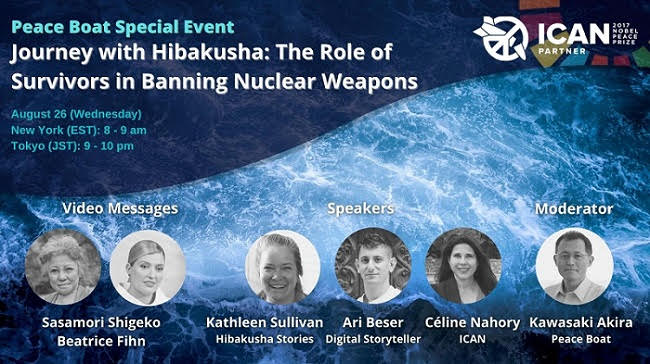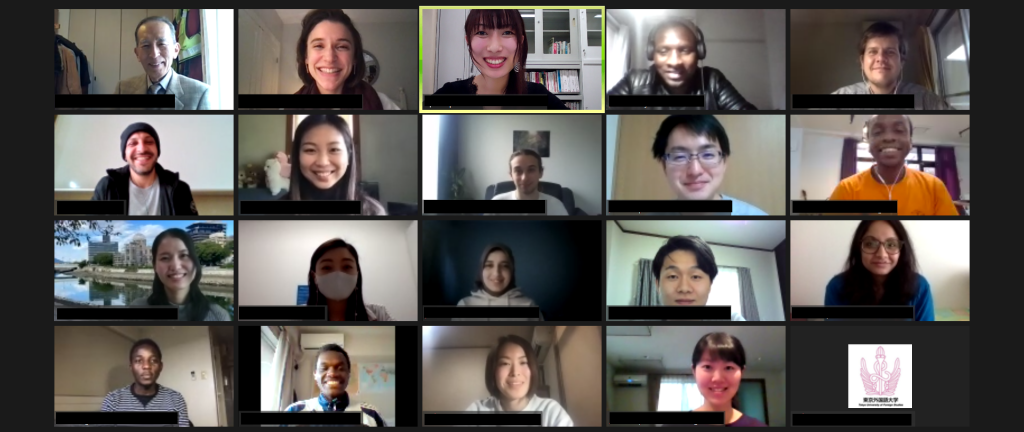大学の世界展開力強化事業(アフリカ)がNPO法人 Peace Culture Villageの協力の下、実施した広島オンラインツアーに参加しました。広島と長崎の被爆について学んだのは高校生の頃。平和紛争学を専攻する学生として広島と長崎の復興に強い関心を示すジャスタスは、被爆者たちとの対話から、本を読むだけでは得られない貴重な知恵と知識を学んだようです。
以下、ジャスタスのエッセイになります。
Before I came to Japan, I had studied about Hiroshima and Nagasaki destruction during my high school history classes. When I went to Rwanda at my home university, I meet several Japanese and we participated in the Hiroshima and Nagasaki commemoration by watching movies and photo galleries which showed how these places were destroyed and the consequences that followed.
I remember on 2020/8/26, I was invited to attend the Hiroshima Peace Program Seminar organized by the Japan Peace boat, in that seminar, I was more impressed by one of the hibakushas (nuclear survivor) Mrs. Sasamori Shigeko sensei who was 18 years by the time of Hiroshima bombing, she narrated her horrible and traumatic experience and why she got committed in the struggle against nuclear proliferation. Her experience and other speaker's presentation made me more curious to know about Hiroshima and Nagasaki post-war reconstruction in addition to the role of Japan in peacebuilding and peacekeeping as well as trauma healing.

Attending Hiroshima Peace Program Seminar while at my home university
Back to the tour, TUFS in cooperation with Peace Culture Village organized the virtual Hiroshima tour. The chief guest was one of the war survivors Mr. Soh Horie supported by the Peace Culture Village moderators. The tour was highly diverse with participants from Japan, Canada, Tunisia, Syria, Burundi, Japan, America, Uganda, Nepal, and Senegal. The tour took place in three phases, in the first phase we had a lecture about how Hiroshima looked like before, during, and after the war. In the second phase, we had a chance to ask a question to the guest and in the third phase, we discussed our impressions on the tour as well.

In the first phase, the guest presented his experience of how Hiroshima was destroyed and the challenges he faced after the death of his family members. Just like many other hibakushas, he too was an anti-nuclear proliferation activist. He presented reasons why we should join him in his anti-nuclear proliferation struggle, he reasoned that the war wastes recourse, money, leads to death of the innocent, displacement, environmental destruction, etc. during his presentation, he expressed his concern over the Fukushima nuclear plant since they might explode in case of any mistake like an earthquake. After his presentation, we had a virtual tour where we saw some pictures of Hiroshima before the bombing and how Hiroshima looked after, and the current beautiful Hiroshima.
Even though I wished to see Hiroshima physically and observe things on my own, the pictures on this tour were so educational, they showed how Hiroshima has been reconstructed. I was impressed by how the participants were so passionate about maintaining peace based on their different historical experiences. The tour helped me to ensure more knowledge about Hiroshima, especially from the war survivor. Actually, I enjoy meeting and discussing with the war survivors on matters concerning peace, security, and nuclear proliferation. They have deep historical knowledge with experience which we may not get by just reading books but by interacting with them and listening to their wisdom. I believe that, before the hibakushas or war survivors die with thier wisdom, the young generation should utilize their presence and learn from their experience as we look to the world free of war and nuclear weapons.

